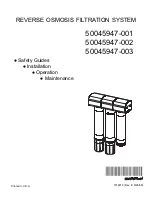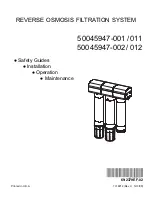
4
General Filter Information
SEDIMENT FILTER
A sediment filter removes sand, dirt, clay, silt, and fine
organic matter from water. You can see sediment in
water by filling a clear drinking glass and holding it up
to a light. The sediment particles are either suspend-
ed in the water, or settled to the bottom of the glass.
The mineral bed in the sediment filter is a ‘‘filter aggre-
gate’’ material. The bed traps and holds the sediments
as water flows through it. When properly maintained,
the mineral can last indefinitely.
TASTE & ODOR FILTER
Taste & odor filters remove most tastes, odors and cer-
tain organic colors from water. Bad tastes and odors
are due to a variety of causes (chlorine, petroleum,
tannins, etc.). Activated carbon mineral, used in this
filter, has a high capacity for adsorbing these impuri-
ties.
The activated carbon mineral bed usually lasts for
about one year before it’s exhausted. High amounts of
tastes and odors, and/or higher water usages may
shorten this time. Activated carbon can’t be regenerat-
ed and must be replaced when exhausted (see page
16).
WATER NEUTRALIZING FILTER
All water, when chemically analyzed, is either acid,
neutral, or base (alkaline). To quantify this, the water
is given a pH value between 0 and 14. Water having a
pH from 0 to 6.9 is acid. A pH of 7 is neutral. Above
7, the water is alkaline.
Acid water, although sometimes clear in appearance,
shortens the life of iron pipe and corrodes copper or
brass pipe and fittings. It causes green or blue stains
on plumbing fixtures, and may etch porcelain enamel
over a period of time.
An acid neutralizer filter is used to treat water with a
pH of 6.0 to 6.8. The filter is filled with a bed of neu-
tralite/magnesium oxide mineral. As acid water passes
through the filter, some of the mineral dissolves to
raise the pH and neutralize the acid. Because the
mineral does dissolve, the filter needs to be refilled.
How often depends on the degree of acidity, and how
much water is used. See page 15 to determine when
refilling is needed.





































